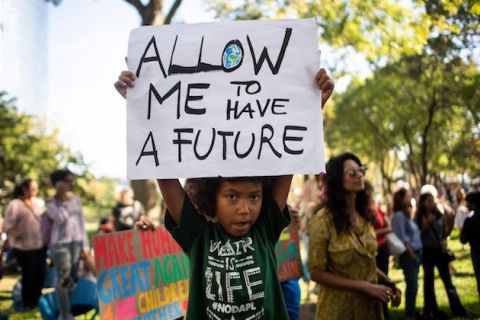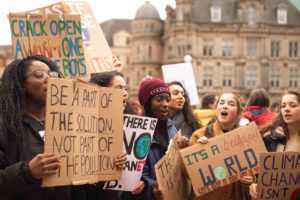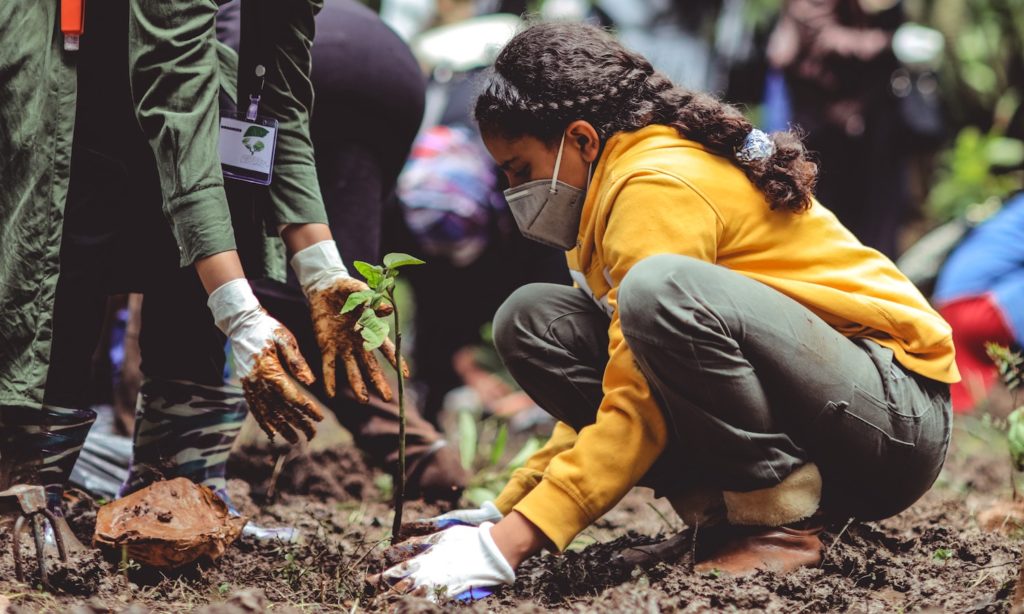The link between the zero-waste movement and environmental justice is inextricable and very powerful. Whilst it may not be news that privilege tends to create a dangerous environment for those without it, the consequences of that dynamic are more severe now than ever before. However, as the window for mitigating the environmental crisis diminishes and social fault lines become deeper and clearer, we are offered the opportunity to undertake important remedial work.
To do this, it is important to understand how the fields of zero waste and environmental justice intersect, allowing us to utilize their relationship to create powerful systemic change. To this end, this article will explore what environmental justice means, how our production systems (and specifically our relationship with waste) perpetuate environmental injustice, and how we can find intersectional solutions to both.
 What is environmental justice?
What is environmental justice?
The Department of energy defines Environmental Justice as:
“…the fair treatment and meaningful involvement of all people, regardless of race, color, national origin, or income, with respect to the development, implementation, and enforcement of environmental laws, regulations, and policies. Fair treatment means that no population bears a disproportionate share of negative environmental consequences resulting from industrial, municipal, and commercial operations or from the execution of federal, state, and local laws; regulations; and policies. Meaningful involvement requires effective access to decision makers for all, and the ability in all communities to make informed decisions and take positive actions to produce environmental justice for themselves.”
The essential takeaway from this is that environmental justice rests on meaningful political enfranchisement by all people, and that no groups are disproportionately affected by an unhealthy environment which has been produced as the result of human action.
 Whilst environmental justice is a valuable goal, we have a long way to go before we can consider it a reality. Both within the US, and internationally, it is the most underprivileged communities that suffer most, often disproportionately affecting Black, Indigenous, and People of Color (BIPOC). Moreover, these negative effects on communities from man-made environmental conditions are often the result of deliberate political disenfranchisement. As such, we are not currently living through a period of environmental justice.
Whilst environmental justice is a valuable goal, we have a long way to go before we can consider it a reality. Both within the US, and internationally, it is the most underprivileged communities that suffer most, often disproportionately affecting Black, Indigenous, and People of Color (BIPOC). Moreover, these negative effects on communities from man-made environmental conditions are often the result of deliberate political disenfranchisement. As such, we are not currently living through a period of environmental justice.
What role does waste play in environmental justice?
Our material economy, and subsequently our relationships with production and waste, have caused much of the environmental degradation which has been experienced across the globe. From the extraction of raw materials out of the ground, through the processing of those materials into goods, to their distribution, consumption and subsequent waste, our consumer economy has drastic environmental costs. The negative role of our material economy on our natural environment is well explained in The Story of Stuff.
 Among the many factors that allow this system to function as it does, land needs to be continually destroyed, and waste needs to be continually disposed of somewhere. Because of the negative environmental consequences associated with those processes, groups with political or financial power and influence will do what they can to avoid having those processes undertaken nearby. Subsequently, these processes and their associated facilities tend to be established closest to the communities with the least political power. As such, social disparities (which have often been established by social injustice) are facilitated and then exacerbated by environmental injustice.
Among the many factors that allow this system to function as it does, land needs to be continually destroyed, and waste needs to be continually disposed of somewhere. Because of the negative environmental consequences associated with those processes, groups with political or financial power and influence will do what they can to avoid having those processes undertaken nearby. Subsequently, these processes and their associated facilities tend to be established closest to the communities with the least political power. As such, social disparities (which have often been established by social injustice) are facilitated and then exacerbated by environmental injustice.
What does waste and environmental injustice look like?
Research verified by the Environmental and Energy Study Institute indicates that 79% of municipal solid waste incinerators, and the majority of landfills, are found in “EJ” or “environmental justice” communities. Living in close proximity to these facilities comes with many associated health risks, including higher rates of asthma, respiratory diseases and cardiovascular diseases
Incinerators are also the primary global source of dioxin, the most toxic man-made substance that we know of. Landfills also have dangerous environmental consequences, creating runoff of contaminated water and other toxic liquids, which can infiltrate and pollute local soil and waterways. In combination, living near landfill and incinerators mean that communities are left with dangerous soil, air, and water.
 Due to these health risks, nobody wants an incinerator in their backyard, so waste companies often look to install their facilities in communities with the least political or financial ability to resist.
Due to these health risks, nobody wants an incinerator in their backyard, so waste companies often look to install their facilities in communities with the least political or financial ability to resist.
Historical and current discriminatory practices such as redlining created those pockets of vulnerability, and so it is frequently the groups which have been most discriminated against, and which live in these pockets, who end up living in proximity to dangerous facilities.
This is why the majority of EJ communities in the US are also BIPOC communities; the political vulnerability created by racist practice and legislation has allowed for continued exploitation within the material economy. EJ communities exist and are maintained due to a combination of unhealthy systems of production and systemic discrimination, and subsequently highlight where environmental justice and the zero-waste movement intersect.
The exploitation of the politically and economically disenfranchised is not a practice limited by national borders, however. It is also experienced on a global level. Powerful economies, such as the US which demands 30% of the world’s resources, and creates 30% of the world’s waste, need to look abroad to fulfill the needs of their current supply chains. Inevitably, it is the groups with the least power who have their land and labor exploited in order to provide the cheapest solutions for powerful countries and corporations.
How can zero waste support environmental justice?
The zero-waste movement has the potential to take significant steps towards achieving environmental justice.
 Firstly, it can immediately reduce the strain on EJ communities. By implementing zero-waste principles on a global level, we can directly reduce the processes which create negative environmental conditions. For example, with effectively implemented cradle-to-cradle thinking, pressure is taken off the environments in which new raw materials are extracted and disposed of, thus improving the conditions of the people living there, and the symptoms of environmental injustice.
Firstly, it can immediately reduce the strain on EJ communities. By implementing zero-waste principles on a global level, we can directly reduce the processes which create negative environmental conditions. For example, with effectively implemented cradle-to-cradle thinking, pressure is taken off the environments in which new raw materials are extracted and disposed of, thus improving the conditions of the people living there, and the symptoms of environmental injustice.
Secondly, the zero-waste movement has the capacity to support the independent development of EJ communities. In order for zero waste to work, we need to develop more closely integrated local economies which are better equipped to utilize and circulate the natural and human resources which they have readily available. By moving towards zero waste, we are able to support the conditions within EJ communities for them to develop local economies, thus gaining financial and political power, and tackling the conditions which allow for environmental injustice.
In order to create this reality, we need to put pressure on governments and producers. We need to ensure that zero waste-informed legislation is introduced at all levels of government, and that producers will be held accountable for their waste during each stage of production through extended producer responsibility. We also need to support anti-racist programs and legislation which work to reverse the damage created by racist practices such as redlining and help to create long term resilience against further forms of social and environmental injustice.
Zero waste can also support environmental justice closer to home
Looking closer to our own homes, the first and most simple step we can take is to continue our personal zero-waste journeys and encourage those around us to do the same. This can help to reduce the amount of waste sent to landfill or incineration, and simultaneously reduce the demand for new items further upstream of production.
 Yet the beneficial impact of our zero-waste journeys can be compounded significantly by buying, where we can, from EJ communities themselves, and supporting grassroots activism. Whilst government investment in EJ communities is important, the best solution to environmental and social injustice is to help communities in their own development work. As such, doing what we can to nurture local economies, local environmental workers, and local zero-waste networks helps to support and sustain self-directed resilience within EJ communities.
Yet the beneficial impact of our zero-waste journeys can be compounded significantly by buying, where we can, from EJ communities themselves, and supporting grassroots activism. Whilst government investment in EJ communities is important, the best solution to environmental and social injustice is to help communities in their own development work. As such, doing what we can to nurture local economies, local environmental workers, and local zero-waste networks helps to support and sustain self-directed resilience within EJ communities.
If we want to move away from our current harmful systems of production, we need to develop parallel systems towards which we can transition, and zero waste is an excellent example of this type of system. For more information on how to work towards zero waste in your home, community, or business, check out the zero waste blog, or find out more about the work of the Zero Waste International Alliance.

